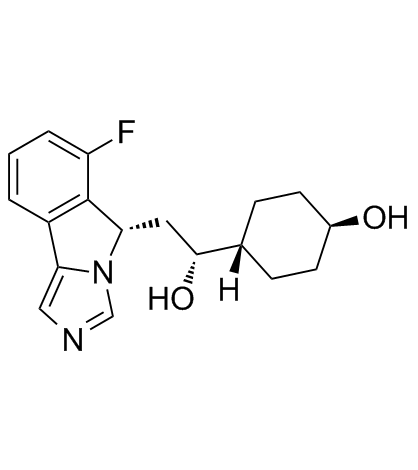1402837-78-8
| Name | Navoximod |
|---|---|
| Synonyms |
926SHL95NC
5H-Imidazo[5,1-a]isoindole-5-ethanol, 6-fluoro-α-(trans-4-hydroxycyclohexyl)-, (αR,5S)- navoximod UNII:926SHL95NC trans-4-{(1R)-2-[(5S)-6-Fluoro-5H-imidazo[5,1-a]isoindol-5-yl]-1-hydroxyethyl}cyclohexanol |
| Description | Navoximod is a potent IDO (indoleamine-(2,3)-dioxygenase) pathway inhibitor with Ki/EC50 of 7 nM/75 nM. |
|---|---|
| Related Catalog | |
| Target |
IDO:7 nM (Ki) IDO:75 nM (EC50) |
| In Vitro | Using IDO-expressing human monocyte-derived dendritic cells (DCs) in allogeneic mixed lymphocyte reaction (MLR) reactions, Navoximod (NLG919) potently blocks IDO-induced T cell suppression and restores robust T cell responses with an ED50=80 nM. Similarly, using IDO-expressing mouse DCs from tumor-draining lymph nodes, Navoximod abrogates IDO-induced suppression of antigen-specific T cells (OT-I) in vitro, with ED50=120 nM[1]. Navoximod inhibits the IDO activity in a concentration-dependent manner with an EC50 of 0.95 μM. PEG2k-Fmoc-NLG(L) is less active (EC50 of 3.4 μM) in inhibiting IDO compared with free Navoximod while PEG2k-Fmoc-NLG(S) is least active (EC50>10 μM). Coculture of IDO+tumor cells with splenocytes isolated from BALB/c mice leads to significant inhibition of T-cell proliferation. This inhibition is significantly attenuated when the mixed cells are treated with Navoximod. PEG2k-Fmoc-NLG(L) is also active in reversing the inhibitory effect of tumour cells although slightly less potent than Navoximod [3]. |
| In Vivo | VNavoximod (NLG919) is orally bioavailable (F>70%); and has a favorable pharmacokinetic and toxicity profile. In mice, a single oral administration of Navoximod reduces the concentration of plasma and tissue Kyn by ~50%. In vivo, in mice bearing large established B16F10 tumors, administration of Navoximod markedly enhances the anti-tumor responses of naïve, resting pmel-1 cells to vaccination with cognate hgp100 peptide plus CpG-1826 in IFA. In this stringent established-tumor model, Navoximod plus pmel-1/vaccine produce a dramatic collapse of tumor size within 4 days of vaccination (~95% reduction in tumor volume compare to control animals receiving pmel-1/vaccine alone without Navoximod)[1]. When combined with Temozolomide (TMZ)+radiation therapy (RT), both Navoximod and 1-methyl-D-tryptophan (D-1MT, indoximod) enhance survival relative to mice treated with TMZ+RT alone[2]. |
| Cell Assay | The IDO inhibitory effect of PEG2k-Fmoc-NLG is tested by an in vitro IDO assay. Briefly, HeLa cells are seeded in a 96-well plate at a cell density of 5000 cells per well and allowed to grow overnight. Recombinant human IFN-γ is then added to each well with a final concentration of 50 ng/mL. At the same time, various concentrations of PEG2k-Fmoc-NLG(L), PEG2k-Fmoc-NLG(S) or Navoximod (NLG919) (50 nM-20 μM) are added to the cells. After 48 h of incubation, 150 μL of the supernatants per well is transferred to a new 96-well plate. Seventy-five μL of 30% trichloroacetic acid is added into each well and the mixture is incubated at 50°C for 30 min to hydrolyse N-formylkynurenine to kynurenine. For colorimetric assay, supernatants are transferred to a new 96-well plate, mixed with equal volume of Ehrlich reagent (2% p-dimethylamino-benzaldehyde w/v in glacial acetic acid), and incubated for 10 min at RT. Reaction product is measured at 490 nm by a plate reader[3]. |
| Animal Admin | Mice[2] Mice are anesthetized with 4% isoflurane, and the surgical plane of anesthesia is maintained with 2% isoflurane in oxygen. Mice are immobilized in a stereotactic frame for tumor implantation. Briefly, the skull is shaved and exposed with a 0.5 cm skin incision. With antiseptic technique, 105 GL261 cells (suspended in 3 μL RPMI-1640) are injected at the following coordinates with respect to the bregma on the right side (antero-posterior, -2 mm; medio-lateral, 2 mm; dorso-ventral, 3 mm). This placement reproducibly yielded tumor growth in a paracortical area of the posterolateral right frontal lobe. Tumor-bearing mice are treated with combinations of oral DL-1MT (2 mg/mL D-1MT mixed with 2 mg/mL L-1MT) in drinking water, D-1MT (4 mg/mL) in drinking water, Navoximod (6 mg/mL) in drinking water, intraperitoneal cyclophosphamide, intraperitoneal temozolomide, and/or total-body radiation (500 cGy from a 137Cs source), as detailed in figure legends. Mice are observed daily, and sacrificed when they became ill or moribund[2]. |
| References |
| Density | 1.4±0.1 g/cm3 |
|---|---|
| Boiling Point | 555.4±35.0 °C at 760 mmHg |
| Molecular Formula | C18H21FN2O2 |
| Molecular Weight | 316.370 |
| Flash Point | 289.7±25.9 °C |
| Exact Mass | 316.158691 |
| LogP | 1.28 |
| Vapour Pressure | 0.0±1.6 mmHg at 25°C |
| Index of Refraction | 1.683 |
| Storage condition | 2-8℃ |
